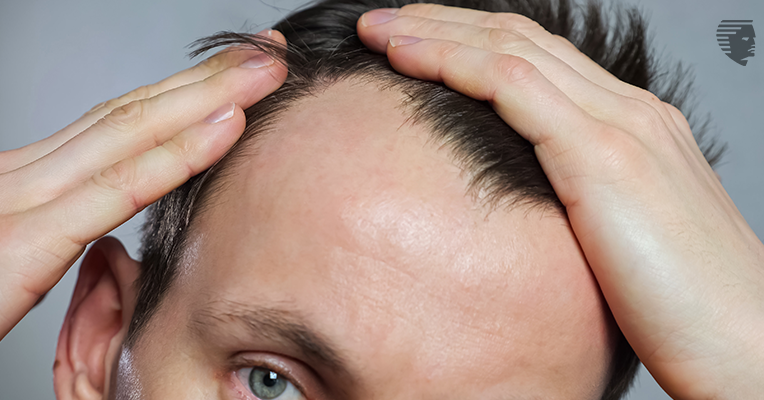Some men are blessed with lifelong locks. But besides those fortunate few, balding is a reality that most must face at some point in their lifetime.
Now, there’s no shame in embracing the bald. For some it can even improve their look. However, if you don’t want to give in — if you want to fight the tide of time — then you’re in luck. Because there are more options for combating a receding hairline now than ever before. Read on to learn about how you can bring your fivehead back down to a forehead.
Manage it With Medication
If you want to fight the five, you’ve gotta target it directly. The good news is you don’t need to be a conquistador on a suicide mission to discover the fountain of youth anymore. These days, there are incredible hair-reviving medications that you can have delivered to your door at the click of a button.
When it comes to hair-loss medication, you’ll likely want to get either finasteride or minoxidil. Finasteride stops hair loss by blocking your body’s conversion of testosterone into the hormone dihydrotestosterone. DHT is known to bind to your scalp, causing your hair follicles to shrink and stop producing hair. So, simply put, the less DHT you produce, the less your widow’s peak becomes a widow’s summit.
Minoxidil, on the other hand, increases blood flow to your scalp. To produce hair, your scalp needs a steady supply of oxygen. And your blood is oxygen’s ticket to your scalp. So, in this case, the more blood flowing there, the better. Try a topical finasteride and minoxidil for a dual-pronged assault on your hairline’s recession. By using a product that combines them both, you get the best of both worlds in one application.
Also Read : Social Media Mastery: Leveraging Platforms for Effective Business Marketing
Pick the Perfect Pigment
Hair medications are amazing at curbing and potentially even reversing hair loss. However, admittedly, they can take a few months before they kick into high gear. What are you supposed to do in the meantime?
One option is to dye your scalp. No, seriously. Micropigmentation is actually a fairly sophisticated process that aims to restore a fuller sense of color to your head. As your hair gets thinner, more and more swaths of scalp shine through the follicles. By strategically dying parts of your scalp with non-toxic pigment, you can create the illusion of a full head of hair.
While this option doesn’t treat the cause of hair loss, it does help fight it aesthetically. If you do pursue this option, just be sure to work with a professional you trust. Though micropigmentation is not an invasive procedure, its effects are long-lasting. So you want to make sure you work with someone who’s competent and familiar with the process.
Also Read : Tutors of Tomorrow: How AI Avatars Are Transforming Education
Borrow Hair From Elsewhere
The funny thing about running out of hair up top is that you tend to keep growing it elsewhere. So why not shave off some of that excess and put it on your head? Like medication and micropigmentation, a hair transplant is another long-term option for the fight. However, it’s also a more invasive option, requiring extensive time and funds to complete. So, like with micropigmentation, you want to find a competent surgeon you can trust to carry out this procedure.
While there have been a variety of hair transplant procedures over the decades, currently there are two popular forms of hair transplantation to consider. Follicular unit transplantation is slightly older. It involves removing a strip of skin containing hair follicles from the donor area. That strip is then dissected into individual follicular units and transplanted onto the bald areas of the scalp.
Follicular unit extraction, or FUE, on the other hand, is less invasive as it involves extracting individual follicular units directly with a micro-punch tool. Similarly, these units are then transplanted onto the scalp. Some people prefer FUE to FUT because FUE tends to leave less noticeable scarring. However, both have their benefits and are worth considering if you think transplantation could be a good option for you.
Blast Your Head With Lasers
Do you like lasers? Well, you’re in luck. Because their usefulness is no longer relegated just to kids’ birthday parties and sci-fi movies. Lasers may be able to save your scalp.
Low-Level Laser Therapy is a non-invasive treatment that uses either lasers or diodes to stimulate cellular activity on your scalp. Also known as red light or cold laser therapy, LLLT has become an increasingly popular option to consider in recent years. LLLT works in a few ways, one of which is through cellular stimulation. As your hair follicles absorb the laser light, it stimulates blood flow, providing more energy for the cells to grow.
This is similar to minoxidil. Again, improved blood flow ensures that your follicles receive the proper nutrients and oxygen they need to grow. Finally, LLLT is also believed to activate dormant follicles, transitioning them from a resting to a growth phase. This can result in thicker, healthier looking hair over time.
Arm Yourself
As you can see, there are many tools you can use to fight the good fight against hair loss. And the options listed here are just some of the most common and effective people use. There are others to consider too, such as platelet-rich plasma therapy, stress management techniques, exercise routines, and more.
Even better, you don’t need to limit yourself to one technique or approach: mix and match them as you see fit. There’s no one right way to fight hair loss. So get out there and see what works best for bringing your fivehead back down to a forehead.

